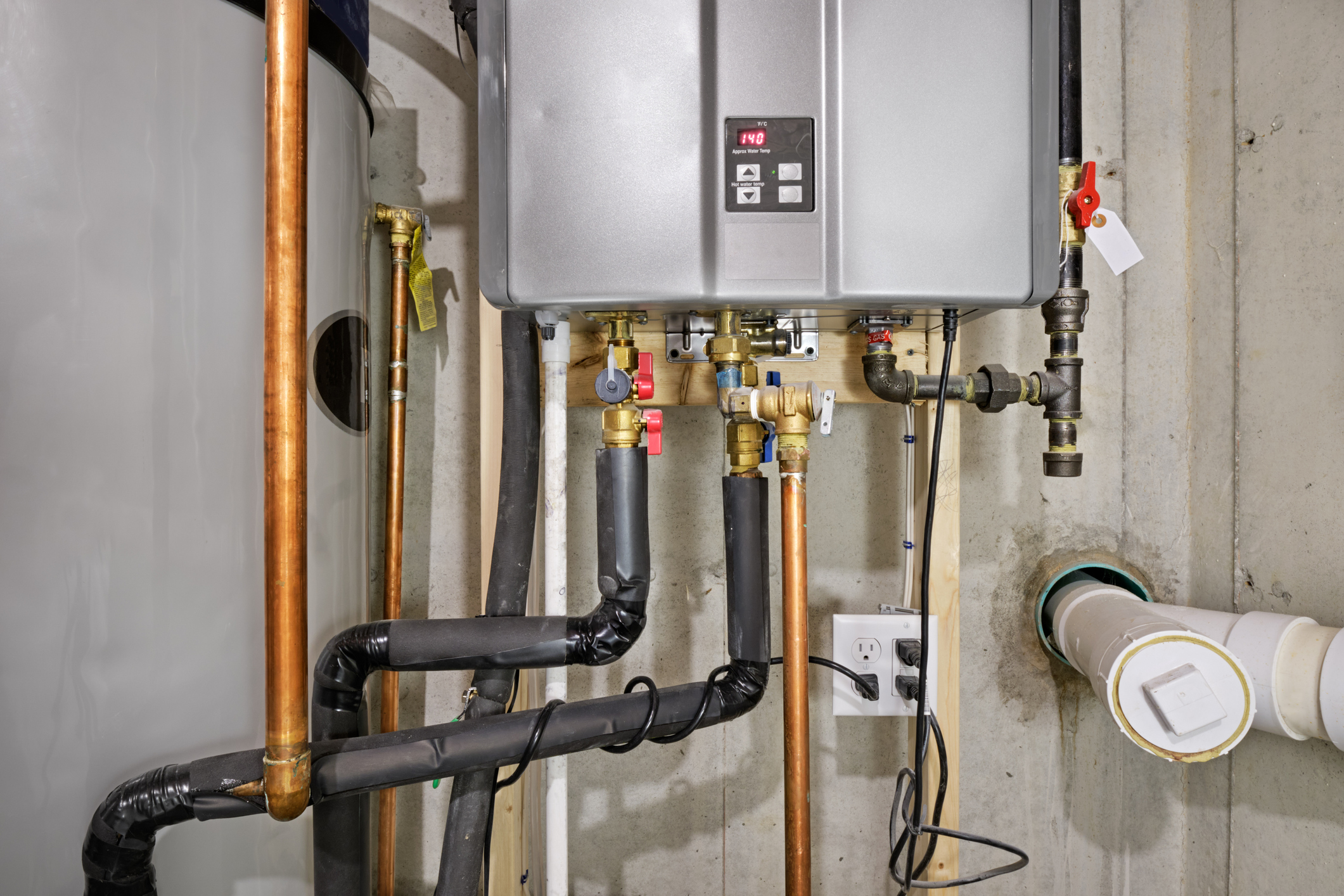For most individuals and families, a home is the biggest purchase that will ever be made. Protect this investment during the wintertime by taking the opportunity to winterize your property from top to bottom
Use our free winter preparation checklist this year to get your home ready!
For a printable version of this checklist, click here!
- Have your Furnace or Heat Pump professionally serviced.
It’s critical that you service your furnace or heat pump every year without fail. Without the proper maintenance, you run several risks, including: paying more than you should in cold-weather utility bills, experiencing potential health hazards (e.g., carbon monoxide poisoning, allergies from mold or dust) and forcing unnecessary wear-and-tear on your unit(s). - Clean/replace filters in your heating system
The filters in your heating system act as a screen against any unwanted airborne particles that might otherwise make it into your home. If they are dirty, it’s important to address the situation before any problems occur. - Change the direction of your ceiling fans (clockwise) for winter
This is a “must do” that rarely gets done, but it can have a very positive effect on your utility bills! When ceiling fans are running in a clockwise direction, they send the warmer air (which gathers on the ceiling) down and into the actual living space. - Close high vents and open low vents
Because hot air rises, it’s important to make certain your vents that are close to the ceiling aren’t pumping out heat that won’t be felt by those living in your household. By closing them and opening the lower vents, you can maintain a better room temperature. - Change the batteries in your smoke detectors
This is one “must do” that you can’t do without. Even if your smoke detectors seem to be working, replace the batteries. You will never regret making this decision, but if you put it off another year, you may regret not doing something. - Turn the water off to outdoor faucets
Cold weather can mean frozen outdoor drains. By turning the water off to spigots, you can eliminate the chances of experiencing a winter “flood” (aka, exploding water pipes) in your home. - Disconnect hoses, drain and put them away
If any of your hoses are still connected to outdoor faucets, remove them, drain them and store them (indoors, preferably.) They’ll be ready to go next spring when you need them again, and they won’t suffer through a winter on the frozen ground. - Remove screens and install storm doors/windows
This simple act can take a bite out of your energy bill. Storm doors and windows, when properly fitted, are a smart weapon against paying more than is absolutely necessary to your utility provider. - Remove window air conditioners
There’s no reason to keep window air conditioners in place over the winter, as doing so provides yet another way for cold air to get into your home and increases the possibility of the air conditioner’s life being shortened. After removing the air conditioner, clean it off, clean/change the filter and store it for next year. - Put outdoor toys away
The kids might not understand the benefits to putting their toys in a shed, basement, garage or attic, so it’s important to explain to them that toys can be broken, lost or destroyed if they are left out during the wintertime months. They can also cause the landscape to look like an eyesore, which no homeowner wants. - Move sensitive plants indoors
If you’ve spent all spring and summer cultivating plants that cannot stand the harshness of winter, it’s time to find a good place for them indoors. Just make sure when you do that they are not poisonous to any household pets. (If they are poisonous, have a friend take care of the plants or put them in a room to which the pets do not have access.) - Cover lawn furniture and grills to protect from the elements
Unless you plan to grill your Thanksgiving turkey, it’s time to put everything away. But first, wash all your outdoor patio furniture and peripheral items. You’ll be glad you did when it’s time to dust them off in the spring. - Make sure your snow shovels are in good order
We live in central Pennsylvania, so before you know it, the snow is going to fly. It’s also going to settle on the ground. Even if you have a snow blower, it’s good to have a back-up plan. Therefore, you’ll need to ensure your snow shovels are clean and ready to perform. (Hint: Keep a can of WD40 handy if you have an older metal/aluminum shovel whereupon the snow tends to stick in clumps. A few sprays will enable the snow to slide off with ease.) - Start and run snow blowers
Speaking of wintry conditions, if you use a snow blower, now is the time to fire it up and make sure it’s in excellent working order. Waiting until you need it can end in disaster and frustration. - Start and run generators
Back-up generators are ideal for use during the colder months. Give yourself peace of mind by starting and running any you have at your residence, just to make certain you can use it/them when the time comes. - Stock up on fuel for snow blowers and generators
Having snow blower and/or generator fuel on hand will provide you with a measure of security and convenience. Plus, with rising fuel prices, it may save you significant amounts of money to purchase this necessity in advance. - Seal gaps and cracks around windows and doors
Studies have shown that most houses (especially older ones) have areas where heat “escapes” through cracks in windows, doors, chimneys, attics, etc. By addressing any places where this is problematic, you’ll be saving yourself the cost of utility bills during the winter months. - Close off whole house fans
Whole house fans are ideal for sping, summer and early autumn, but they are unnecessary during the winter months. By closing yours off, you’ll be able to not only protect your fan, but also eliminate an area where hot air can escape.
- Check for/repair all water leaks
Water leaks can be more than a mere annoyance, especially during times of the year when the thermometer plummets. To avoid having to deal with frozen, bursting pipes, now is the best time to check the house for any “red flags”… and then remedy them. - Insulate pipes in crawlspaces and in unheated basements
Has it been a long time since you checked your crawlspace(s) and/or unheated basement areas? Dress in your “working” outfit and do a thorough examination of all pipes. Any that are exposed should be insulated before the weather turns any colder. - Check for and repair roof leaks
It almost goes without saying that roof leaks can pose a huge issue during cold months when ice and snow gather on roofs. Thus, grab a ladder and (carefully!) explore your roof. Or, hire a professional to do so. If you find any problems, address them immediately. - Have fireplace chimney cleaned
Whether or not you’re planning to use your fireplace(s) this winter, it’s a good idea to get your chimney cleaned. Complications of which you were previously unaware (e.g., fire hazards, structural issues, unhealthy build-ups of toxic substances) can be hiding in chimneys. - Install insulating curtains or window sheeting if you have old windows
Older windows may have attractive characteristics, but they are unlikely to be energy-efficient. If you’re not planning to replace them with upgraded versions, you’ll want to invest in insulating curtains or window sheeting to keep them from costing you money through leaked hot air. - Stock up on wood/pellets etc.
If you use your fireplace or woodstove, you’ll need fuel throughout the winter. Autumn is the ideal time of the year to make your purchases, because you won’t be in a rush. You’ll also be able to plan where to store your fuel. - Keep salt on hand to treat sidewalks, if needed
Have you ever run out of salt after a particularly nasty snowstorm? It happens regularly in our region of Pennsylvania, and it can be more than a mere annoyance; if someone slips and falls because your sidewalks are icy, it can become a liability. Buy a couple of bags of rock salt now and keep them safely stored. You’ll be glad you planned in advance. - Clean all gutters and downspouts
Removing debris from gutters and downspouts is hardly a glamorous chore, but it will keep your home from becoming a target for flooding, rotting siding and other structural problems. If you are loathe to accomplish this task yourself, it is always wise to consider hiring a professional. - Trim trees if branches are hanging near power lines
Though power companies often trim trees to ensure power lines are uncompromised by the risk of falling/leaning tree limbs, they can overlook certain places. Take a stroll around your property (even if it’s small) to ensure that no trees contain branches that could become a hazard to power lines. - Check the insulation in your attic
Attics should always be insulated, but even if yours appears to be completely protected, it’s a good idea to get the insulation level checked. Older insulation (or insulation that has been improperly installed) can be deceptively inadequate. - Leave your kitchen and bathroom cabinet doors open when the temperature is near freezing
As the temperature begins to dive closer to 32°F, it’s a smart idea to keep all kitchen and bathroom cabinet/vanity doors open to avoid frozen pipes. That way, you won’t awaken to an icy mess on the inside of your residence. - Order propane/oil
Planning for the inevitable future involves ordering propane/oil from your preferred company. That way, you’ll be set to stay toasty without worry that you’ll run out suddenly and without warning. - Vacuum duct vents and/or baseboard heating units
Duct vents and baseboard heating units take a beating all year round, so why not make autumn the time to clean them out? That way, no debris, dust, pollen or other items can escape into your home’s air. - Make sure furnace and water heater vents are free from obstructions outside
The vents in your home that are exposed to the outside cannot work effectively if there are items in the way. Thus, make sure that all vents can work properly. (Cleaning them out is also recommended.) - Seal up cracks along the foundation to keep critters from finding their way in
Foundational cracks look like “green light” invitations to small animals and insects seeking warmth and shelter during colder times of the year. By addressing any cracks in your home’s foundation, you’ll have less of a chance of your residence become a “critter hotel” this year! - Set your programmable thermostat back at night
The best part about having a programmable thermostat is that you can set it to heat your home at a different temperature during the night than you have during the day. Besides, there’s no reason for your house to be fully heated while you’re sleeping. (The human body actually rests more comfortably when temperatures are cooler.) - Put comforters/extra blankets on the beds
Comforters, blankets and throws are inexpensive measures to stay snug all winter without spending more on heating. Keep them on beds, sofas and other places where the people in your home frequently gather to watch television, read, check the Internet and rest. - Check your inventory of gloves/hats/snow boots/winter coats
Ever had trouble finding the matching pair to a glove? It’s a frustration that can be avoided with a bit of preparation. Sorting through all your winter apparel will make grabbing the right outdoor items easy when the time comes to head out into the frosty air. (This is an especially useful operation if you have kiddos who have grown considerably since last year, and who will need larger boots and jackets!) - Check your emergency kit
Every household needs to have an emergency kit stocked with first aid materials from A to Z. (If you don’t have one at the ready, they’re easy to put together; alternatively, they can be purchased at almost any drugstore or grocery.) If you have items like over-the-counter medicines in your kit, examine their expiration dates. If any are no longer useful, dispose of them properly and purchase replacements. - Drain gas from your lawnmower
Chances are good that after mid-October, you’ll no longer need your lawnmower on a regular basis. Consequently, around that time, you should drain all the gas from the equipment. This will help keep your lawnmower in good working order when you rev it up in the spring. - Seal your deck
Didn’t have the opportunity to seal your wood deck or porch area this summer? Don’t delay. By sealing it before the temperature begins to cool down, you’ll protect your deck’s structural integrity. - Purchase (or dig out) candles
There’s nothing wrong with keeping some candles on hand, just in case flashlights fail or kerosene lamps won’t work. You’ll never regret having a supply for that evening when the power goes off! (Tip: Keep matches with the candles.) - Prune your shrubs
Now is the perfect time of the year to prune back the shrubs around your house, shed, garage, etc. Doing so will not only make your property look better, but will be better for the plants, too. - Trim any tree branches hanging over your roof
The last thing you and your family need is an ice-laden branch falling on the roof during the chill of a winter’s day or night. By trimming your tree limbs ahead of time, you’ll lessen the odds that this will become an issue. - Remove any debris that is resting against the house
Leaves, mulch and other items should not be left “resting” against your home. Otherwise, they can cause mildew and rot, damaging the exterior of your residence. Simply bag them, or use them in a composting pile or composter. - Buy some bottles of water
When the water supply is compromised due to the effects of winter weather or flooding, you’ll need to have water handy. Often, you can buy bottles or gallons of water for very little. Alternatively, you can simply bottle up tap water and store it in your shed, garage, basement or pantry area. - Check your chemical fire extinguisher, or purchase one
A chemical fire extinguisher is always a smart item to have on hand. If you already have one, check to see if it has expired. And if you don’t have one, go to your favorite supply store and invest in one.
For a printable version of this checklist, click here!






